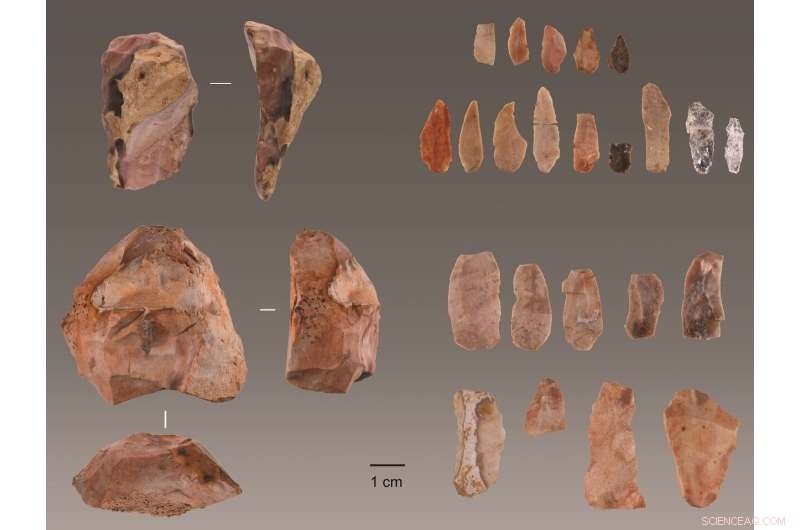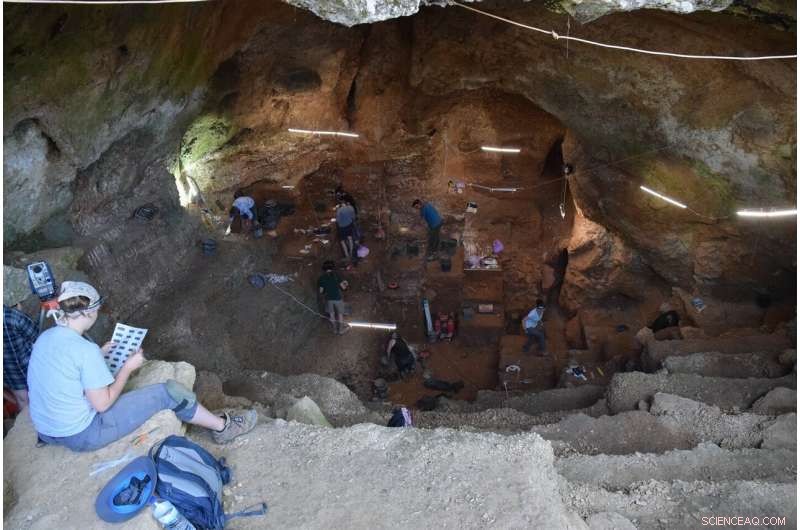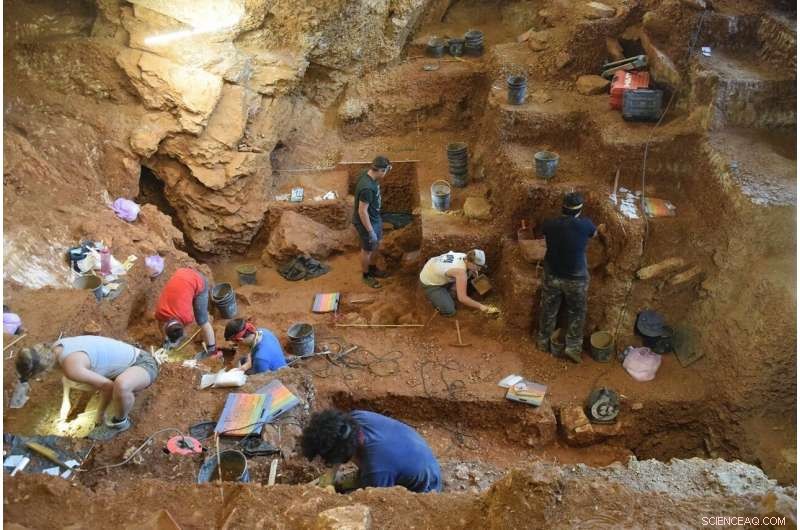
Wetenschap
De moderne mens bereikte het meest westelijke Europa 5, 000 jaar eerder dan voorheen bekend

Gereedschap ontdekt in Lapa do Picareiro in Midden-Portugal. Krediet:Jonathan Haws.
De moderne mens arriveerde in het meest westelijke deel van Europa 41, 000-38, 000 jaar geleden, ongeveer 5, 000 jaar eerder dan voorheen bekend was, volgens Jonathan Haws, doctoraat, professor en voorzitter van de afdeling Antropologie aan de Universiteit van Louisville, en een internationaal team van onderzoekers. Het team heeft de ontdekking van stenen werktuigen die door moderne mensen worden gebruikt, daterend uit de eerdere periode onthuld in een rapport dat deze week in het tijdschrift is gepubliceerd Proceedings van de National Academy of Sciences .
Het gereedschap, ontdekt in een grot genaamd Lapa do Picareiro, gelegen nabij de Atlantische kust van centraal Portugal, link de site met soortgelijke vondsten uit heel Eurazië naar de Russische vlakte. De ontdekking ondersteunt een snelle westwaartse verspreiding van moderne mensen over Eurazië binnen een paar duizend jaar na hun eerste verschijning in Zuidoost-Europa. De tools documenteren de aanwezigheid van moderne mensen in het uiterste westen van Europa in een tijd waarin eerder werd gedacht dat Neanderthalers in de regio aanwezig waren. De bevinding heeft belangrijke gevolgen voor het begrijpen van de mogelijke interactie tussen de twee menselijke groepen en de uiteindelijke verdwijning van de Neanderthalers.
"De vraag of de laatst overgebleven Neanderthalers in Europa zijn vervangen of geassimileerd door inkomende moderne mensen, is een al lang bestaande, onopgeloste kwestie in paleoantropologie, " zei Lukas Friedl, antropoloog aan de Universiteit van West-Bohemen in Pilsen, Tsjechië, en projectleider. "De vroege data voor Aurignaciaanse stenen werktuigen in Picareiro sluiten waarschijnlijk de mogelijkheid uit dat moderne mensen in het land zijn aangekomen dat lang verstoken was van Neanderthalers, en dat is op zich al spannend."
Tot nu, het oudste bewijs voor de moderne mens ten zuiden van de rivier de Ebro in Spanje kwam van Bajondillo, een grot aan de zuidkust. De ontdekking van stenen ontlasting gekenmerkt als Aurignaciaans, technologie geassocieerd met vroegmoderne mensen in Europa, in een veilige stratigrafische context in Picareiro leveren definitief bewijs van vroegmoderne menselijke komst.
"Bajondillo bood verleidelijk maar controversieel bewijs dat moderne mensen eerder in het gebied waren dan we dachten, Haws zei. "Het bewijs in ons rapport ondersteunt zeker de Bajondillo-implicaties voor een vroegmoderne menselijke komst, maar het is nog steeds niet duidelijk hoe ze hier zijn gekomen. Mensen migreerden waarschijnlijk langs oost-west stromende rivieren in het binnenland, maar een kustroute is nog steeds mogelijk."
"De verspreiding van anatomisch moderne mensen over Europa, vele duizenden jaren geleden, staat centraal in ons begrip van waar we vandaan kwamen als een nu wereldwijde soort, " zei John Yellen, programmadirecteur archeologie en archeometrie bij de National Science Foundation, die het werk ondersteunden. "Deze ontdekking biedt significant nieuw bewijs dat zal helpen bij het vormgeven van toekomstig onderzoek naar wanneer en waar anatomisch moderne mensen in Europa zijn aangekomen en welke interacties ze mogelijk hebben gehad met Neanderthalers."

Uitzicht op Lapa do Picareiro die vanaf de ingang naar binnen kijkt. Krediet:Jonathan Haws
De Picareiro-grot wordt al 25 jaar opgegraven en heeft de afgelopen 50 jaar een record van menselijke bewoning opgeleverd. 000 jaar. Een internationaal onderzoeksteam van het Interdisciplinair Centrum voor Archeologie en Evolutie van Menselijk Gedrag (ICArEHB) in Faro, Portugal, doet onderzoek naar de komst van de moderne mens en het uitsterven van Neanderthalers in de regio.
Het project wordt geleid door Haws, Michael Benedetti van de Universiteit van North Carolina Wilmington, en Friedl, in samenwerking met Nuno Bicho en João Cascalheira van de Universiteit van Algarve, waar ICarEHB is gehuisvest, en Telmo Pereira van de Autonome Universiteit van Lissabon.
Met steun van subsidies van de Amerikaanse National Science Foundation aan Haws en Benedetti, het team heeft rijke archeologische vondsten ontdekt, waaronder stenen werktuigen in combinatie met duizenden dierlijke botten van de jacht, slagerij en kookactiviteiten.
Sahra Talamo van de Universiteit van Bologna, Italië, en het Max Planck Instituut voor Evolutionaire Antropologie in Leipzig, Duitsland, joined the research team to determine the age of the early modern human and Neanderthal occupations. She used state-of-the-art bone pretreatment and accelerator mass spectrometry (AMS) to date the bones that show evidence of butchery cut marks and intentional breakage by humans to extract bone marrow, a highly prized and nutritious food consumed by ancient people. The dating results place the modern human arrival to the interval between 41, 000 and 38, 000 jaar geleden. The last Neanderthal occupation at the site took place between 45, 000 and 42, 000 jaar geleden.
"The radiocarbon results from Lapa do Picareiro are not only very precise in terms of the dating method, but also demonstrate the meticulous work of the archeologists at the site, " Talamo said. "The importance of collaboration between the radiocarbon specialist and the archaeologists is essential in order to obtain an accurate chronology like in the case of Picareiro."
Spatial analysis of high-resolution three-dimensional data confirmed the precise stratigraphic relationships between artifacts and radiocarbon samples and revealed discrete layers of occupation at the site.
"Analysis of high-resolution spatial data is crucial for documenting and observing lenses of human occupation and reconstructing occupational patterns, especially in cave environments where complex formation processes exist, " said Grace Ellis, een doctoraat student at Colorado State University studying landscape archaeology and ancient settlement patterns.

View of the excavation of the early modern human (foreground) and Neanderthal layers (background) of Lapa do Picareiro. Credit:Jonathan Haws
This was backed up by artifact refitting that showed the stone tools were not moved through post-depositional processes.
"Refitting is a task that requires a lot of time and patience, and in this case, it really was worthwhile because the results verified the geospatial observations, " said Pereira, an archaeologist who specializes in stone technology.
While the dates suggest that modern humans arrived after Neanderthals disappeared, a nearby cave, Oliveira, has evidence for Neanderthals' survival until 37, 000 jaar geleden. The two groups may have overlapped for several thousand years in the area.
"If the two groups overlapped for some time in the highlands of Atlantic Portugal, they may have maintained contacts between each other and exchanged not only technology and tools, but also mates. This could possibly explain why many Europeans have Neanderthal genes, " said Bicho, director of ICArEHB.
"Besides genetic and archeological evidence, high-resolution temporal context and fossil evidence across the continent is crucial for answering this question. With the preserved key layers dated to the transitional period, we are now awaiting human fossils to tell us more about the nature of the transition, " Friedl said.
Despite the overlap in dates, there does not appear to be any evidence for direct contact between Neanderthals and modern humans. Neanderthals continued to use the same stone tools they had before modern humans arrived, bringing a completely different stone technology.
"Differences between the stone tool assemblages dated before and after about 41, 000 years ago are striking at Picareiro, " said Cascalheira, an ICArEHB board member and specialist on stone tool technology. "Older levels are dominated by quartzite and quartz raw materials and marked by the presence of Levallois technology, a typical element of Neanderthal occupations in Europe. Aurignacian levels, anderzijds, are dominated by flint and the production of very small blades that were likely used as inserts in arrow shafts for hunting."
Flint also was used to make tools for butchering animals such as red deer, ibex and possibly rabbits. The team recovered a few red deer canine teeth, often used as personal adornments, but so far these do not show traces of manufacturing jewelry.
"The bones from Lapa do Picareiro make up one of the largest Paleolithic assemblages in Portugal, and the preservation of these animal bones is remarkable, " said Milena Carvalho, een doctoraat candidate at the University of New Mexico and ICArEHB researcher studying the diets and paleoecology of Neanderthals and modern humans. "The collection will provide tremendous amounts of information on human behavior and paleoecology during the Paleolithic and we will be studying it for decades."
The cave sediments also contain a well-preserved paleoclimatic record that helps reconstruct environmental conditions at the time of the last Neanderthals and arrival of modern humans.
"We studied changes in the size of limestone clasts and the chemistry of muddy fine sediment filling the cave to understand the paleoclimatic context for the transition, " Benedetti said. "Our analysis shows that the arrival of modern humans corresponds with, or slightly predates, a bitterly cold and extremely dry phase. Harsh environmental conditions during this period posed challenges that both modern human and Neanderthal populations had to contend with."
The cave itself has an enormous amount of sediment remaining for future work and the excavation still hasn't reached the bottom.
"I've been excavating at Picareiro for 25 years and just when you start to think it might be done giving up its secrets, a new surprise gets unearthed, " Haws said. "Every few years something remarkable turns up and we keep digging."
 Nieuwe studiemodellen impact van afkalven op terugtrekking van Thwaites-gletsjer
Nieuwe studiemodellen impact van afkalven op terugtrekking van Thwaites-gletsjer Kust van Texas gebruikt kerstbomen om door storm geteisterde duinen te herbouwen
Kust van Texas gebruikt kerstbomen om door storm geteisterde duinen te herbouwen India's droogperiode van 50 jaar en daaropvolgende omkering - strijd tussen natuurlijke en antropogene variabiliteit
India's droogperiode van 50 jaar en daaropvolgende omkering - strijd tussen natuurlijke en antropogene variabiliteit Seismologen bezorgd over bevingen in DR Congo
Seismologen bezorgd over bevingen in DR Congo Hoe de Aqualim-douchekop werkt
Hoe de Aqualim-douchekop werkt
Hoofdlijnen
- Pompoengenomen gesequenced, ongewone evolutionaire geschiedenis onthullen
- Onderzoekers ontdekken de onverwachte atomaire structuur van koude- en mentholsensor TRPM8
- Een beschrijving van het doel van mitose
- The Differences Between Kinetochore & Nonkinetochore
- Twee hersengebieden werken samen om vinken te helpen weten wanneer en hoe ze hun liedjes moeten afstemmen op specifieke situaties
- Hoe een tRNA-sequentie uit een DNA-sequentie te krijgen
- Soorten redeneringen in Geometry
- What Influences Phenotype?
- Het hormoon dat uw hond agressief zou kunnen maken
- Nederlanders opgraven Romeins kanaal, weg in de buurt van UNESCO-erfgoedlocaties

- Nieuwe manieren waarop wetenschappers kunnen helpen wetenschap terug in de populaire cultuur te brengen

- Brexit-debat op Twitter gedreven door economische en nationalistische kwesties, geen populisme

- Kleinschalige verzamelaars lieten meer dan voetafdrukken achter in het landschap

- Hoe klinkt een normale stem?

 We kunnen de toekomstige kosten van klimaatverandering niet kennen. Laten we ons in plaats daarvan concentreren op de kosten om het te vermijden
We kunnen de toekomstige kosten van klimaatverandering niet kennen. Laten we ons in plaats daarvan concentreren op de kosten om het te vermijden ontwortelen, hoe klein je plant ook bent, is een trauma:oudere vrouwelijke huurders hebben het moeilijk
ontwortelen, hoe klein je plant ook bent, is een trauma:oudere vrouwelijke huurders hebben het moeilijk Waarom vormt bier een schuim, maar frisdrank niet?
Waarom vormt bier een schuim, maar frisdrank niet?  Onderzoekers bouwen autonome loopmachine op nanoschaal van DNA
Onderzoekers bouwen autonome loopmachine op nanoschaal van DNA Littekens achtergelaten door Australische onderzeese aardverschuivingen onthullen toekomstig tsunami-potentieel
Littekens achtergelaten door Australische onderzeese aardverschuivingen onthullen toekomstig tsunami-potentieel Centimeters converteren naar centimeters Squared
Centimeters converteren naar centimeters Squared Een röntgencamera die tienduizenden röntgenkleuren kan oplossen
Een röntgencamera die tienduizenden röntgenkleuren kan oplossen Negatief gaan loont voor nanobuisjes:team vindt mogelijke sleutels tot betere nanovezels, films
Negatief gaan loont voor nanobuisjes:team vindt mogelijke sleutels tot betere nanovezels, films
- Elektronica
- Biologie
- Zonsverduistering
- Wiskunde
- French | Italian | Spanish | Portuguese | Swedish | German | Dutch | Danish | Norway |

-
Wetenschap © https://nl.scienceaq.com

